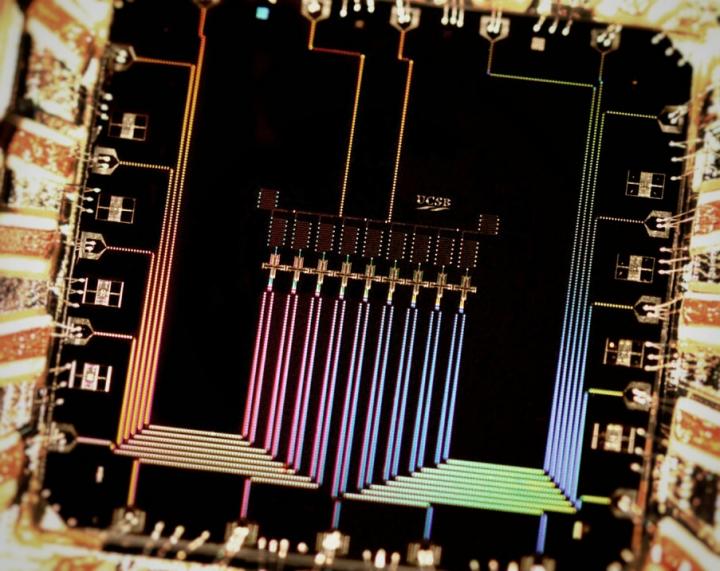Strength in numbers

This is a photograph of the nine qubit device. The device consists of nine superconducting 'Xmon' transmons in a row. Qubits interact with their nearest neighbors to detect and correct errors. Credit: Julian Kelly
When scientists develop a full quantum computer, the world of computing will undergo a revolution of sophistication, speed and energy efficiency that will make even our beefiest conventional machines seem like Stone Age clunkers by comparison.
But, before that happens, quantum physicists like the ones in UC Santa Barbara's physics professor John Martinis' lab will have to create circuitry that takes advantage of the marvelous computing prowess promised by the quantum bit (“qubit”), while compensating for its high vulnerability to environmentally-induced error.
In what they are calling a major milestone, the researchers in the Martinis Lab have developed quantum circuitry that self-checks for errors and suppresses them, preserving the qubits' state(s) and imbuing the system with the highly sought-after reliability that will prove foundational for the building of large-scale superconducting quantum computers.
It turns out keeping qubits error-free, or stable enough to reproduce the same result time and time again, is one of the major hurdles scientists on the forefront of quantum computing face.
“One of the biggest challenges in quantum computing is that qubits are inherently faulty,” said Julian Kelly, graduate student researcher and co-lead author of a research paper that was published in the journal Nature. “So if you store some information in them, they'll forget it.”
Unlike classical computing, in which the computer bits exist on one of two binary (“yes/no”, or “true/false”) positions, qubits can exist at any and all positions simultaneously, in various dimensions. It is this property, called “superpositioning,” that gives quantum computers their phenomenal computational power, but it is also this characteristic which makes qubits prone to “flipping,” especially when in unstable environments, and thus difficult to work with.
“It's hard to process information if it disappears,” said Kelly.
However, that obstacle may just have been cleared by Kelly, postdoctoral researcher Rami Barends, staff scientist Austin Fowler and others in the Martinis Group.
The error process involves creating a scheme in which several qubits work together to preserve the information, said Kelly. To do this, information is stored across several qubits.
“And the idea is that we build this system of nine qubits, which can then look for errors,” he said. Qubits in the grid are responsible for safeguarding the information contained in their neighbors, he explained, in a repetitive error detection and correction system that can protect the appropriate information and store it longer than any individual qubit can.
“This is the first time a quantum device has been built that is capable of correcting its own errors,” said Fowler. For the kind of complex calculations the researchers envision for an actual quantum computer, something up to a hundred million qubits would be needed, but before that a robust self-check and error prevention system is necessary.
Key to this quantum error detection and correction system is a scheme developed by Fowler, called the surface code. It uses parity information — the measurement of change from the original data (if any) — as opposed to the duplication of the original information that is part of the process of error detection in classical computing. That way, the actual original information that is being preserved in the qubits remains unobserved.
Why? Because quantum physics.
“You can't measure a quantum state, and expect it to still be quantum,” explained Barends. The very act of measurement locks the qubit into a single state and it then loses its superpositioning power, he said. Therefore, in something akin to a Sudoku puzzle, the parity values of data qubits in a qubit array are taken by adjacent measurement qubits, which essentially assess the information in the data qubits by measuring around them.
“So you pull out just enough information to detect errors, but not enough to peek under the hood and destroy the quantum-ness,” said Kelly.
This development represents a meeting of the best in the science behind the physical and the theoretical in quantum computing — the latest in qubit stabilization and advances in the algorithms behind the logic of quantum computing.
“It's a major milestone,” said Barends. “Because it means that the ideas people have had for decades are actually doable in a real system.”
The Martinis Group continues to refine its research to develop this important new tool. This particular quantum error correction has been proved to protect against the “bit-flip” error, however the researchers have their eye on correcting the complimentary error called a “phase-flip,” as well as running the error correction cycles for longer periods to see what behaviors might emerge.
Martinis and the senior members of his research group have, since this research was performed, entered into a partnership with Google.
Media Contact
All latest news from the category: Information Technology
Here you can find a summary of innovations in the fields of information and data processing and up-to-date developments on IT equipment and hardware.
This area covers topics such as IT services, IT architectures, IT management and telecommunications.
Newest articles

NASA: Mystery of life’s handedness deepens
The mystery of why life uses molecules with specific orientations has deepened with a NASA-funded discovery that RNA — a key molecule thought to have potentially held the instructions for…

What are the effects of historic lithium mining on water quality?
Study reveals low levels of common contaminants but high levels of other elements in waters associated with an abandoned lithium mine. Lithium ore and mining waste from a historic lithium…

Quantum-inspired design boosts efficiency of heat-to-electricity conversion
Rice engineers take unconventional route to improving thermophotovoltaic systems. Researchers at Rice University have found a new way to improve a key element of thermophotovoltaic (TPV) systems, which convert heat…



